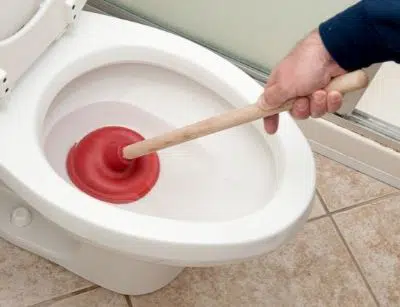There’s nothing more frustrating than flushing your toilet only to watch that swirling vortex refuse to drain, leaving you dealing with an unsightly and unsanitary mess. A perpetually clogging toilet quickly escalates from a minor inconvenience into a plumbing crisis demanding immediate attention. After all, who wants to be constantly plunging and snaking their way through clogs?
The tricky part? Pinpointing the root cause behind those constant backups isn’t always so obvious. It could be something as simple as an improper flushing technique. Or you might be dealing with more complex culprits like obstructive buildup, low water levels, or even systemic drainage issues.
This guide explores the most common reasons toilets become chronic cloggers, equipping you with the troubleshooting knowledge to keep your porcelain throne flushing like a dream. No homeowner should resign themselves to dealing with that revolting overflow!

Common Causes of Toilet Clogs
Even the most high-efficiency toilets can’t defy the laws of plumbing physics forever when constantly forced to evacuate inappropriate materials. Understanding what leads to those dreaded backups provides your first line of defense against clogging woes.
Flushing Non-Flushable Items
We’ve all been there – mindlessly dropping something in the bowl and giving it that fateful flush without a second thought. But toilets simply aren’t designed to handle anything beyond waste and toilet paper. Feminine products, baby wipes, paper towels, and other supposedly “flushable” items quickly turn into drainage nightmares. Those materials don’t disintegrate properly, binding to waste and creating obstructive knots.
Too Much Toilet Paper
Speaking of toilet paper, even that can spell trouble when overused. Older low-flow models particularly struggle once their drain lines get overloaded with excess paper breaking down too gradually. While it seems wasteful, going easier on each flush prevents those massive wads from congealing.
Older Low-Flow Toilets
Since we brought them up, it’s worth noting that outdated low-flow and low-flow toilet designs often lack the powerful flush needed to keep drain lines clear. Their reduced water volumes just can’t generate enough force to consistently sweep away bigger solid waste buildups. Upgrading to modern high-efficiency models provides a permanent solution.
Hard Water and Mineral Buildup
If your home receives hard water supplies, chances are those mineral-rich liquids gradually leave behind crusty residue coating drain interiors over time. As that buildup accumulates, it severely restricts water flow generating chronic clogs. Using chemical drain cleaners or partnering with plumbers for hydrojetting service clears out that calcified gunk.
Blocked Plumbing Vents
Most residential plumbing configurations include rooftop vent stacks allowing air circulation smoothing water flow. When those vents get obstructed by debris, birds’ nests, or even ice dams, they create a vacuum effect causing suction that literally pulls water back down drain lines. Clearing those vent obstructions restores proper drainage.
Sewer Line Issues
Of course, sometimes toilet clogs originate way further down that hidden pipeline headed to municipal sewer mains or residential septic tanks. Cracked pipes, infiltrating tree roots, and sewer line collapses or clogs all impede waste transit triggering constant toilet backups. Sewer line inspections using cameras identify those underground offenders.
As diverse as those potential causes seem, the end result remains revoltingly the same – waste contents defiantly sloshing back up into homes. Getting ahead of those clogging triggers through proper flushing habits and plumbing maintenance provides your most reliable defense.
Identifying the Source of the Clog
Once you’ve taken that distressing look into the bowl only to find an unsightly backup situation, your next objective involves pinpointing just where that clogging culprit is hiding. Without that critical information, you risk wasting time treating symptoms rather than resolving the actual issue at its source.
Start by grabbing that trusty plunger and giving it a few forceful pumps directly into the toilet drain. If that successfully clears the obstruction allowing the bowl to drain, chances are you just dislodged some miscellaneous buildup specific to that toilet’s drain trap. An easy win!
However, if vigorous plunging fails to alleviate the clog, you’ll need to perform a bit more hands-on sleuthing. Remove the toilet tank lid and take a look inside the overflow tube leading into the bowl. If you spot the water levels higher than normal, that indicates the blockage exists further down the drain line beyond just that individual toilet.
Your next step? Grab a toilet auger (that long segmented metal snake tool) and attempt feeding it gradually into the bowl to physically break through the clog. If the auger detects the obstruction and manages to bore a path, problem solved! Just run some water to flush it all out.
But if you’ve snaked as far as the auger line extends with no progress, that points to the clog originating even deeper within those drain pipes or potentially the main sewer line itself. At this juncture, you’ve got two main options:
- Attempt using a plumber’s high-pressure water jetting auger to blast through blockages beyond your auger’s reach. These powerful machines send concentrated streams forceful enough to pulverize obstructions like tree roots and hardened buildup. Renting these specialty tools makes that an affordable DIY approach for seasoned handymen.
- Or play it safe and schedule an appointment with a professional plumber. Their video inspection cameras can locate clogs with precision, potentially identifying larger systemic issues while their industrial equipment thoroughly clears even the most stubborn drainage stoppages quickly.
Taking that extra bit of time isolating the clog’s location not only prevents unnecessary labor but ensures any remedies you attempt actually resolve the underlying issue. Who wants to put in all that hard work only for the problem to resurface again?
Solutions for Persistent Toilet Clogs
So you’ve identified the general location of that stubbornly persistent clog, but still can’t seem to make any progress actually dislodging it. Maybe the plunger and auger just won’t cut it against whatever gunk is gumming up those pipes. Don’t dismay – you’ve still got an entire arsenal of potential fixes worth deploying before admitting defeat!
DIY Fixes
Let’s start with some heavy-duty clog-busting measures the determined do-it-yourselfer can tackle safely. These chemical and mechanical approaches really pack that extra punch when plungers prove inadequate:
Chemical Drain Cleaners
You know those industrial-strength liquid drain openers marketed specifically for tough clogs? While they should always be used with caution given their hazardous contents, their hydroxide-based formulas can effectively dissolve through the nastiest of obstructions like hair, grease, and soap scum buildups.
For best results, follow product instructions precisely. That usually involves pouring the chemical drain cleaner directly into the bowl, letting it work its magic for a while, then flushing repeatedly with hot water to fully clear the treatment. Proper protective gear like gloves and goggles is highly recommended!
Baking Soda and Vinegar
Looking for a more natural, fume-free option? That classic baking soda and vinegar concoction can work surprising wonders too. Start by pouring about a half cup of baking soda down the clogged drain, then chase it with an equal amount of vinegar. Let that sit for 15-20 minutes as the soda and vinegar interact, creating carbon dioxide gas that can potentially break up the clog.
Once time’s up, flush the drain with several rounds of very hot water straight from a kettle. The rapid temperature change and carbon dioxide expansion help dislodge even stubbornly sticky obstructions. It’s an eco-friendly approach worth a try first!
Wet/Dry Vacuum
Still having trouble getting that clog to budge? Bringing in a wet/dry vacuum provides another mechanical solution. The extreme suction power of these machines can sometimes accomplish what plungers alone cannot.
Just remove the toilet tank lid, seal the vacuum nozzle directly over the drain hole, and engage that maximum suction setting. This concentrated pulling force has been known to successfully extract all sorts of gunked-up debris blockages that manual snakes just push further down pipes. Be prepared for a nasty discharge!
When to Call a Professional
Of course, even the handiest of homeowners will inevitably encounter clogs too severe or deep-rooted for those DIY methods to resolve on their own. Knowing when to admit defeat and solicit professional help prevents those minor annoyances from escalating into full-blown plumbing emergencies demanding costly repairs.
If you’ve exhausted all those drain cleaning tricks without success and your toilet still refuses to drain properly, don’t keep fighting a losing battle. Continuous flushing and plunging often does more harm than good once obstructions pass beyond that toilet drain trap area. At that point, you’ll want certified plumbers equipped with high-powered jetting equipment and video camera inspections to get eyes directly on the problem.
Their arsenal of specialized tools stands the best chance of dislodging even the most stubborn clogs and pinpointing any systemic issues like bellied pipes or collapsed sewer lines causing those constant backups. While you may have to pay for their professional service, those experts can get you quickly back in working order while saving you from inadvertently damaging your entire plumbing system through improper unclogging techniques.
So don’t keep subjecting your household to that unsanitary overflow situation any longer than absolutely necessary. No amount of elbow grease can fix certain clogs – knowing when to call in the pros ensures that porcelain throne gets back to flushing like a dream sooner!
Preventive Measures
They say an ounce of prevention is worth a pound of cure, and that old adage certainly rings true when it comes to avoiding toilet clogs. While dealing with the occasional clogged bowl might be an inevitability of homeownership, some simple preventative habits can dramatically reduce how frequently you find yourself reaching for that plunger.
Start by making sure everyone in your household understands what can and cannot be flushed down toilets. Seems basic, but you’d be amazed how many plumbing headaches stem from inappropriate items like feminine products, baby wipes, and cotton balls getting deposited where they don’t belong. Make it a strict rule – unless it’s bodily waste or small amounts of toilet paper, it doesn’t go in the bowl!
You’ll also want to keep a close eye on just how much toilet paper you use per flush. Older low-flow models in particular can struggle clearing excessive wads that clump together into obstructive masses. Teach family members to be judicious with TP amounts while getting into a habit of giving stuck paper remnants a courtesy second or third flush if needed.
On the maintenance front, having a plumber periodically inspect your sewer line and run a video scope helps catch developing obstructions before they inevitably trigger a full-blown clog. These professionals use high-pressure hydrojetting wands to scour away built-up debris and tree root infiltrations that gradually choke off smooth drainage flows. Staying ahead of these issues prevents backups!
You may also want to consider upgrading to a modern, high-efficiency toilet if your home still uses an outdated low-flow model. Newer designs offer significantly more powerful, clog-resistant flushes thanks to taller drain traps and improved bowl glazing. That extra muscle makes a huge difference in sweeping away potential obstructions.
At the end of the day, no preventative measure proves 100% foolproof against the occasional clogged toilet. But adopting better bathroom habits while partnering with plumbers for routine maintenance goes a long way toward minimizing those unsightly overflow episodes. A little conscientious preparation keeps your household’s most important porcelain fixtures flowing freely!
Flush Toilet Troubles Away for Good
No homeowner should have to resign themselves to constantly battling clogged and overflowing toilets. While the occasional minor backup might be unavoidable, taking preventative measures and utilizing proper unclogging methods ensures your porcelain thrones keep flushing freely without drama.
From understanding what can and cannot be flushed, to implementing maintenance routines like hydrojetting sewer lines, this guide equips you with all the knowledge needed to prevent clogs before they happen. And if you do find yourself staring down an unsightly backed-up bowl, you now know the most effective DIY fixes to try resolving things yourself.
But Gene Johnson Plumbing, Heating, Cooling & Electrical always stands ready to assist Seattle area homeowners when plumbing woes demand a professional’s expertise. As a company serving locals since 1976, Gene Johnson’s team brings unmatched experience, quality workmanship, and total transparency to every service call.
Our plumbers utilize state-of-the-art equipment like video inspection cameras to pinpoint clog locations with pinpoint accuracy, then deploy industrial-strength hydrojets to pulverize even the most stubborn obstructions. You can count on our honest recommendations and upfront pricing delivering the efficient clog-clearing solutions you need.
So don’t keep subjecting your household to that revolting overflow nightmare any longer. Call Gene Johnson at 206-792-7495 and let our Seattle plumbing experts get you back to enjoying free-flowing, clog-free toilets quickly! With our help, reclaiming that porcelain paradise has never been easier.





